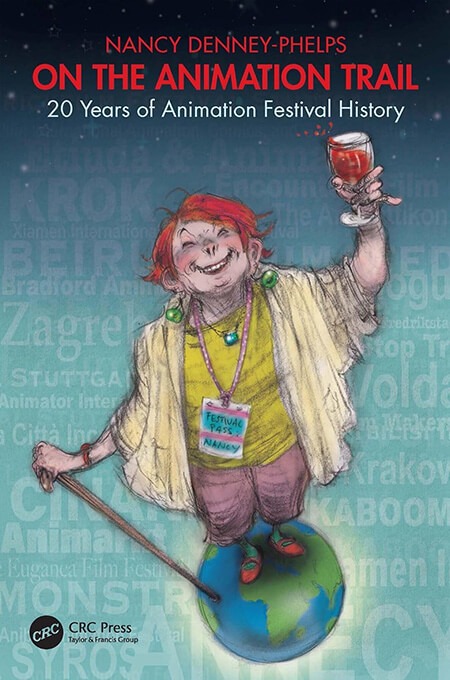On The Animation Trail | Book Review
Any animator who has actively traveled with their films during a festival run will have doubtless crossed paths with Nancy Denney-Phelps. A force of nature unto herself, the prolific industry writer, alongside her composer partner Nik Phelps, are a mainstay on the circuit, her roles spanning juries, selection committees, event hosting and programming, fueled by obligatory airport beers (and sometimes train station wines). Certainly her perfectly-rendered likeness (courtesy of animation legend Joanna Quinn) on the book’s cover will jostle your memory if the name escapes you.

Image: CRC Press
From the firm foundations of countless festival reports over the years, said book is Denney-Phelps’s recent literary venture On The Animation Trail: 20 Years of Animation Festival History, an all-new collection of writings from her years on the circuit. It makes for something of a unique entry in the world of animation literature which, while often either instructional or analytical, is rarely anecdotal (a few exceptions including the informal writings of Bill Plympton and Chris Robinson’s cultural road-trip Canadian Animation: Looking for a Place to Happen). While not a memoir per se, the book serves as a distinctly personal collection of memories and perspectives on the festival circuit over the last couple of decades, beginning with a fateful trip to KROK in 2001.
While these are mostly fond remembrances, they are peppered with turbulent moments here and there, from fraught cross-country journeys met with security rifles and expenditures at every turn, to the near-fatal perils of drinking too much tea. More than anything, the book is a celebration of the people who run these events and imbue them with enough character and engagement to stand out in a sea of low-effort festivals that blithely go through the motions. Sprinkled-in are potted histories of the animation industry, key artists and traditions of different geographical regions, to contextualise how the festivals themselves sit amongst them. Denney-Phelps also dives into the history of many of the events, yielding some interesting revelations and factoids, such as the amusing origins of how KLIK Festival (now Kaboom) came to be named as such, different ways in which festivals dealt with and adapted to the COVID pandemic, and navigating the cost-cutting efforts of governmental entities.
In spite of some major events being absent, or mentioned only fleetingly, the book does feel thorough as a cross-sectional sampling of the contemporary animation festival landscape. Annecy, of course, gets a mention, and a more than reasonable remonstration of how things have changed for the impersonal in recent years. Alongside this are warmer remembrances of the various traditional lakeside shenanigans, as well as the rise and demise of Annecy+, a wonderful fringe event helmed by Nancy and indie legend Bill Plympton, in which films not selected for the official programme would get their own joyfully rustic screening. Other fond memories include the wonderfully hospitable Animafest Zagreb’s annual picnic tradition and an assortment of beautifully unpredictable moments, such as the impromptu composition of a musical score for a film in need of one thanks to an unplanned convergence of musicians at a pre-festival workshop. Of particular interest to myself, as someone who reasonably well-traveled when it comes to the festival scene, are the sections that discuss events that remain on my personal wishlist to one day visit, such as Anibar in Peja Kosovo, Cinanima and Monstra in Portugal and Budapest’s Anilogue.
By virtue of being told through such a personal lens, On The Animation Trail feels refreshingly informal whilst remaining informational throughout. Occasional side-effects of this approach includes showing enthusiasm for certain problematic figures in the industry, and those who might have attended or helped organise certain aspects of some of the events discussed might remember them playing out differently and with different people. Ultimately this is in service to the anecdotal charm of the book; stories are told as though over a glass of wine or obligatory airport beer, with their edges sometimes a little blurred and through rose-tinted glasses.
An especially valuable quality of a book such as this is that it provides an answer to one of the most frequently asked questions from students and industry newcomers – “what’s the point of festivals?” In this digital area where online exposure is seemingly king, the dismissal of the perceivably archaic festival experience denies new talents not just a wealth of opportunities for their work to be part of something that physically brings people together, but also the potential to forge a wealth of cherished and valuable friendships and professional collaborations – and come away with some great stories to tell. Whilst the Skwigly team’s own hypothetical compendium of festival misadventures is a ways off, On The Animation Trail makes for an ideal access guide in the meantime.
On The Animation Trail: 20 Years of Animation Festival History is available now through CRC Press


